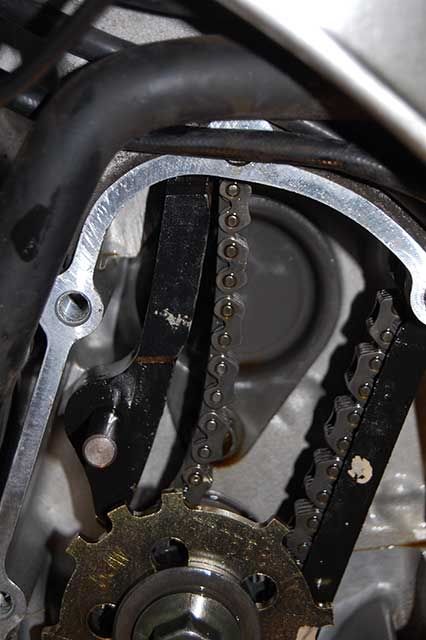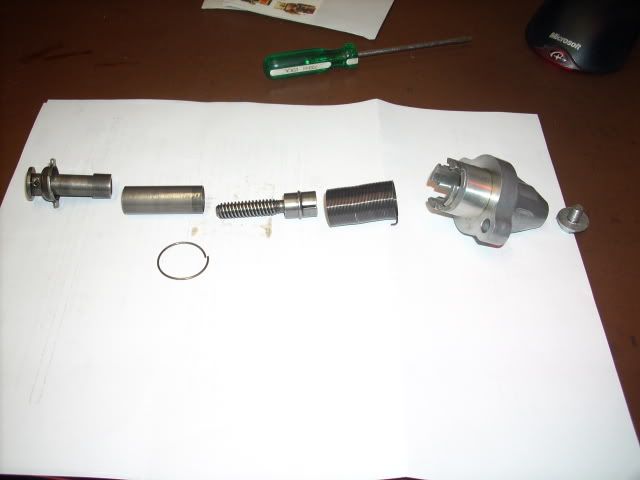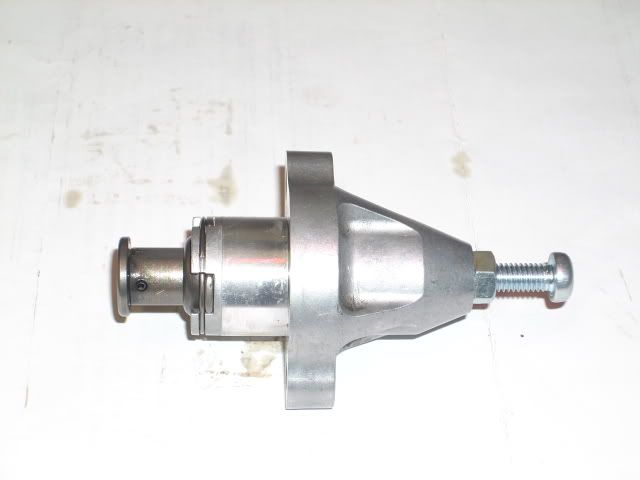Re-reading some of the earlier threads, since I ain't got nothin' better to do, 'cept get ****-faced...
My thinking is that most or all of the catastrophic CCT problems are related to the spring malfunctioning and allowing the tensioner to back way off, thereby allowing the chain to skip a tooth.
Couldn't agree more, except for one thing -- "spring malfunctioning". My problem is CERTAINLY caused by a spring malfunction. The ****** broke. Nothing to add more tension to the chain, and nothing to prevent adjuster "crawl", allowing the adjuster to "back out" and the chain to come loose enough to skip a tooth.
Was I'beam's truly a "malfunction"? Or simply what one might expect due to design, heat de-tempering of the spring, poor pre-tensioning during assembly? Who knows. In Alan's CCT travels, he HAS noted varying amounts of spring tensions with brand new, out-of-the-box CCTs.
A manual chain tensioner won't do that. As the chain wears, it should get very slightly loose and noisy long before the chain is loose enough to jump ship.
Gunny that! And a plunger/adjustment rod that's locknutted in place is NOT gonna "back out" from vibration and chain slap, causing even MORE slack to be injected into the mechanism.
However, will having a slightly loose chain increase the wear rate of the chain, sprockets and slippers?
Logic tells me no, but it depends on how you define "slightly loose chain". I'd guess that the difference between a
perfectly adjusted chain and a noisy chain isn't terribly great. So a "slightly loose chain" would fall in between those two "measurements". I'd bet dollars to donuts that a brand new, 0 mile FJR has "some" deflection in the chain. Not a great amount, of course, but enough that could be defined as "slightly loose".
The idea of a properly functioning automatic chain tensioner is that it keep the chain at the exact perfect tension (no slack) at all times as the chain stretches.
Couldn't agree more. But,
I bet the reason they went for a "clock-spring" arrangement is that the spring force theoretically should remain more constant over the range oif operation that a simple expansion spring.
This part of your sentence I disagree with. Given the size and delicate nature of the spring used in the OEM CCT (VERY fine wire), plus the amount of spring force available from such a weak-assed spring, I'd say the decision to use the design Yamaha used was based entirely on "what worked before" and cost.
In respect to cost, I don't mean the cost of the spring. I'm talking about warranty cost. Think about it...with a MANUAL CCT, owners under warranty would be returning to dealerships every 4-5K miles just to get rid of the low RPM chain noise. Dealers NOT getting paid for a quick tweak of a manual adjuster would get real pissed real fast. And owners would get real pissed with a bike that has to be "adjusted" every few thousand miles, ESPECIALLY out-of-warranty owners. Just think of the rear-drive comparisons made between shafties and sprocket/chain bikes.
The concept of an "automatic" CCT is all well and good, but I tend to think the concept is there to keep everybody happy...the dealer, the owner AND the manufacturer. And unfortunately, it was conceived to cut down on maintenance, NOT because it's a
better solution. We ALL want to spend our time riding, not wrenching, but given the critical function the CCT serves, I'd take a manual over an automatic ANY day.
This seriously seems like the a "Brodie Relay" or KLR "Doo-hickey" type thing that needs a fix engineered for it. The "fix" may just be a better spring or some other mod to the existing mechanism?
I think there alreays IS a "fix" available. Two, in fact. Simplest and most effective, given an owner's willingness to "DIY" is a manual tensioner. The second would be to remove the OEM CCT, disassemble it and add in rotation or two of the plunger to increase the spring tension. The problem I have with #2 is you'd be putting more tension on a spring that, to me, is under-sized (or under-engineered) for the job to begin with.
All this is pure speculation at its best, and unfortunately, too late for my FJR, but I can guarantee you, before I spend another dime on ANYTHING for my other bike, I'm putting a manual CCT tensioner on it.



































































